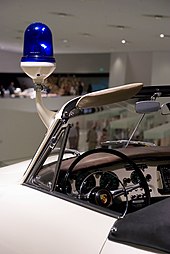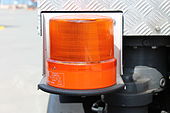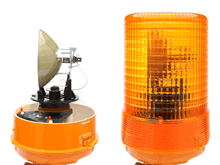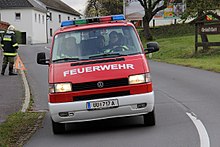Rotating beacon

A rotating beacon ( RKL ), also rotating beacon or beacon (Switzerland), a beacon or warning lamp emits light over a range of 360 °. The best known are rotating mirror lights that emit a circumferential cone of light. Rotating beacons can generally be used for easier visual recognition, marking and securing of danger spots or special locations. They are best known for their use in road traffic, where they are attached to emergency vehicles . They are also used on dangerous systems, machines and devices as well as in alarm systems.
In Germany they are grouped together with the secondary horn as special signals that signal the right of way to other road users .
colour
yellow
Yellow is the most common color for rotating beacons in Germany. It warns of dangers of all kinds on fixed facilities and vehicles. Application examples are closing roller gates, alarm systems, heavy goods transporters, public utility vehicles, gang warning systems in track construction , etc. In older designs , storm warnings on lakes are rotating beacons with two different intervals (40 and 90 revolutions per minute). New warning lights, on the other hand, are designed as flashing lights or flashing lights.
A special area in which the use of yellow lights is internationally regulated is the transport of dangerous goods , such as the tunnel ordinance in ADR .
blue
Blue rotating beacons and other blue flashing lights ( colloquially blue light ) are used in road traffic to indicate emergency vehicles . It warns other road users of deployment, accident and danger spots as well as deployment trips and is also used when escorting convoys .
Blue light was introduced in Germany in 1933. In order to meet the requirements of air protection ( darkening ), it was stipulated that police vehicles were to be equipped with a blue light, since blue light has the highest dispersion in the atmosphere and was therefore no longer visible to bombers at high altitudes. In the same year the fire brigades were assigned to the police forces, the fire protection police . Thus, the fire brigades were also equipped with the blue light. In Austria , the introduction of the blue light after the Anschluss in 1938 was based on a circular issued by the Reichsführer SS. However, the introduction of the flashing light or the rotating beacon instead of a quietly glowing light did not occur until the 1950s.
The Additional Protocol of June 8, 1977 to the Geneva Convention of August 12, 1949 on the Protection of Victims of International Armed Conflicts (Protocol I) provides in Annex I in Article 7 Paragraph 3 that “ambulance vehicles have one or more blue lights that are as widely visible as possible should flash. ”According to paragraph 4, the blue flashing light should emit 60-100 flashes of light per minute. It also defines the color tone.
Another reason for the choice of color is that blue light is unmistakable in road traffic and can therefore be perceived immediately as a warning signal from a distance, since, in contrast to red, yellow, green or white light, it is neither in light signals nor in road , Construction site or other vehicle lighting occurs.
Outside of road traffic, blue rotating beacons are rare; one example of this is taxiway lighting at airports.
Video of a blue light in action
Historic fire police vehicle
Emergency vehicles of the rescue service
red
Red all-round light is rarely found on vehicles in Europe and is sometimes prohibited there (e.g. in Germany and Austria). On the other hand, it is often found on alarm systems, on aviation obstacles such as high-rise buildings or wind turbines , to secure level crossings, for airport lighting and for emergency lighting .
In many other countries, however, especially in the Anglo-American region, but also partly in Eastern Europe, they are used either alone or in combination with blue light to identify emergency vehicles. The fire brigade and rescue service in Austria and partly in Germany also use red rotating beacons for larger missions to identify the task force . They allow emergency vehicles to approach and find the operational management or the operational area on sight. The beacon may only be operated when the vehicle is at a standstill.
Red collision warning lights on an aircraft
Red alarm light on the USS Intrepid
green
Green rotating beacons are also not allowed in road traffic in Germany and Austria , but are sometimes used to identify vehicles (fire brigade: respiratory protection assembly point , operations management (Bavaria)) and locations. In Schleswig-Holstein, a green RKL is used to identify the technical operations management (TEL) of the rescue service at the scene. However, these lights are usually not permanently installed, but are carried by the Organizational Head of the Rescue Service and only installed on the roof of the respective vehicle by means of a magnetic holder after they have arrived at the scene.
In Sweden, too, a green RKL is used at deployment sites to identify the management of the medical rescue service; The Dutch rescue service also uses green beacons to mark the command center in the event of a major damage. In the Netherlands, this is generally taken from the vehicle that arrives first.
In some US states, green RKLs are used as so-called “courtesy lights” for volunteer fire departments. It is intended to signal to other road users that a rescue worker is on duty. Even if, in most states, this lamp does not signal any special rights or rights of way, it is hoped that citizens will cooperate voluntarily. Some states (such as Texas or Utah) also use green rotating beacons to mark emergency command vehicles, as in Bavaria and Austria.
In department stores, underground garages and other larger public buildings, green rotating beacons and the like are used. a. in addition to the mandatory emergency lights used to mark emergency exits.
Construction of a green road clearer
White
White rotating beacons (like yellow or red RKL) are located on building walls to identify a fire alarm system . Since the color is a requirement of the municipality or the district, white RKL are rarely used. The most famous example of a white rotating beacon are the beacons of lighthouses .
Watercraft
Rotating beacons are also used on watercraft. If these flash, they are referred to as sparkling light .
Blue glitter light

Watercraft of certain authorities (e.g. customs , coast guards , water protection police and BPOL ) or water rescue organizations (e.g. DLRG and ASB ) show a blue sparkling light, whereby the use of the blue sparkling light for water rescue is only legal in inland areas. The only exception is the DGzRS when performing sovereign tasks in accordance with Section 1 SeeAufgG. In Bavaria, a blue sparkling light is shown on federal waterways, and a yellow light on state waters (Bavarian shipping regulations).
White sparkling light

On inland waterways , commercial shipping uses a white sparkling light to mark the side of the ship on which oncoming traffic is to take place.
Yellow twinkle light
In the scope of the KVR , a sparkling yellow light designates hovercraft that are not navigating in a water-displacing state.
Assembly
Usually the lights are attached in such a way that they can be seen from all sides (ie "all around"). If they are not, we no longer speak of a round mark light.
The lights can be permanently mounted on vehicles or machines and systems, or they can only be mounted or set up with magnetic holders or clamping or plug-in devices when required (for example on civil patrols ). In emergency vehicles, several lights are often combined with the acoustic warning device in one housing (“ bar ”) so that assembly is easier.
If necessary, several lights can be installed in addition to the rotating beacons. In vehicles, for example, lights can be attached to the front and rear. Because rotating beacons on the vehicle roof cannot be seen in the rear-view mirror if the vehicle in front is not far enough away, front flashers mounted on the radiator grille are used.
Types
The flash pattern of a rotating beacon (RKL) can be generated by a lamp with glass lenses (TriOptics), plastic lenses, rotating mirrors, LEDs or flash discharge tubes.
Rotating mirror light
With conventional rotating mirror lights, there is usually a stationary light source (e.g. a halogen bulb ) in the middle of the RKL. A parabolic reflector rotates around the incandescent lamp, directing a large part of the light in the direction of emission and thus amplifying it. The constant rotation of the reflector leads to the well-known flashing light effect.
There are different drives for the reflector (gear, belt, etc.). There are also models in which several bulbs and reflectors rotate together. The power supply is then established via sliding contacts.
Rotating mirror lights are used as warning lights on machines and systems, to mark dangerous situations or as special signals in road traffic or for demonstration purposes.
Strobe light
More recently, (multiple) flashing lights are often used instead of rotating mirror lights. With these, there is less wear and tear as there are no moving parts. They are also easier to see during the day thanks to their short, high luminous flux .
In addition to single flash lights, there are versions of double, triple and quadruple flash lights. Several flashes of various intensities are emitted. A combination of several flashing lights that flash in a certain order one after the other and thus create the effect of a "running" light is called a running light . These running lights are recognized by road users more quickly than separately operated flashing lights and indicate the route to be taken when securing road construction sites, for example. In Germany, only double flashing lights are permitted for road traffic. Many strobe lights have a Fresnel lens . Often the hood surrounding the flash tube is also fluted vertically and horizontally in order to increase the light exit angle.
The disadvantage of pure flashing lights is that the short time of the flash is not quite sufficient to adequately assess the distance between the observer and the flashing light in spatial vision . For this reason, the LED flashing light is increasingly used, the burning time of which is based more on the lighting time of the classic rotating mirror light.
There are also portable, battery-operated or mains-powered flashing lights.
LED light
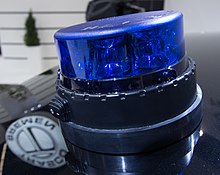
LED lights are characterized by high luminosity as well as low power consumption and wear. They have the advantage of a very low failure probability, which is why they are particularly suitable for machines and systems that do not have failure monitoring installed
Luminaire with lens optics
In the 1950s, a variant of the “deployment blue light 'EBL'”, in which a ring of eight colored cylindrical lenses rotated around the light source and thus modulated the light beam, was particularly widespread in northern Germany . This led to the then characteristic "shimmering" appearance. This type of blue light was used by the Hamburg fire brigade until the early 1970s; it can be seen, for example, in some episodes of the television series " Stahlnetz ".
The lights with plastic lenses or glass lenses are newer, whereby three lenses are always used. In contrast to rotating mirror lights, these have a longer service life, as they only turn at a third of the speed to reach the prescribed warning signal.
Flashing light
A flashing light usually has a light source in the middle. It flashes at regular or irregular intervals. Flashing lights are usually quite cheap and very common on machines and construction site barriers, they usually emit yellow or orange light.
Flashing increases attention and requires less light output to be perceived in a bright environment. Flashing warning lights on machines often indicate unusual conditions.
Approval in road traffic
Regulation in Germany
Yellow all-round light
The use of yellow flashing lights in road traffic is regulated in Germany by the StVO and the StVZO .
In addition, § 38 StVO:
(3) Yellow flashing light warns of danger. It can be used stationary or from vehicles. The use of vehicles is only permitted to warn of work or accident sites, of unusually slow moving vehicles, or of vehicles of unusual width or length or with unusually wide or long loads.
Not everyone is allowed to use yellow beacons in traffic without further ado. In addition, § 52 StVZO says:
(4) With one or, if the horizontal and vertical visibility (geometric visibility) so requires, several beacons for yellow flashing light (all-round light) may be equipped:
- Vehicles that are used for the construction, maintenance or cleaning of streets or systems in the street or that are used for garbage collection and are marked with red and white warning markings (safety markings) that must comply with standard sheet DIN 30 710, March 1990 edition,
- Motor vehicles that are suitable for breakdown assistance according to their design or equipment and which are recognized as breakdown assistance vehicles according to the vehicle registration document. In preparation for its decision, the licensing authority can order the submission of an opinion from an officially recognized expert or inspector for motor vehicle traffic on whether the motor vehicle is suitable for breakdown assistance according to its design or facility. Recognition is only permitted for vehicles from companies that provide breakdown assistance commercially or in-house, from automobile clubs and from associations of the transport industry and car insurers,
- Vehicles with an unusual width or length or with an unusually wide or long load, provided that the approving authority has prescribed the guidance of the beacons,
- Vehicles that are equipped as heavy or large-capacity escort vehicles due to their equipment and are recognized according to the vehicle registration document. Other escort vehicles may be equipped with detachable beacons, provided that the approving authority has prescribed the use of the beacons.
If the above conditions are met, yellow rotating beacons, if necessary after entering them in the vehicle documents, e.g. B. be used on the following vehicles:
- Road administration vehicles (motorway maintenance depot , road maintenance depot, municipal building yards), snow plows or vehicles and self-propelled work equipment from construction companies or forestry and agricultural companies
- Refuse collection vehicles, municipal vehicles (supply and disposal),
- Tractors with extra wide attachments (cultivators, milling machines)
- Trucks that are larger or heavier than "normal": heavy transports, transports with excess length / excess width and their accompanying vehicles ,
- Transporting hazardous materials , where they particularly dangerous road sections, for example in tunnels , must be turned on
- Roadside assistance vehicles (e.g. from automobile clubs )
- Tanks when driving on the road or when the weapon tracking system is activated for repairs or similar. (e.g. responsible for rapid turret rotation in battle tanks)
According to the StVO, however, everyone is always allowed to use approved warning lights on stationary vehicles to warn of danger spots (accident, breakdown, possibly also the end of a traffic jam). § 53a StVZO:
(1) Warning triangles and warning lights must be portable, stable and designed so that they can be seen from a sufficient distance when in use. Warning triangles must be retro-reflective; Warning lights must emit yellow flashing light, be independent of the vehicle's lighting system and have a sufficient burning time. Safety vests must comply with the standard DIN EN 471: 2003 + A1: 2007, March 2008 edition or the standard EN ISO 20471: 2013. The warning devices must be ready for operation.
(2) In motor vehicles, with the exception of wheelchairs, motorcycles and single-axle tractors or work machines, at least the following warning devices must be carried:
- in passenger cars, agricultural or forestry tractors or work machines as well as in other motor vehicles with a gross vehicle weight not exceeding 3.5 t:
a warning triangle; - in vehicles with a gross vehicle weight of more than 3.5 t:
a warning triangle and a warning light separately from it. A portable flashing light in accordance with Section 53b (5) sentence 7 may also be carried as a warning light; - in passenger cars, trucks, tractor units, semitrailer tractors and buses:
a safety vest.
(3) Warning lights that are carried without being prescribed in accordance with Paragraph 2 may, in deviation from Paragraph 1, depend on the vehicle's lighting system, be permanently attached to the vehicle or be designed in such a way that they can be attached inside or outside the vehicle as required can. They must correspond to number 20 of the technical requirements for vehicle parts during the type test according to § 22a of the Road Traffic Licensing Regulations (Verkehrsblatt 1973 p. 558).
(4) Vehicles (with the exception of motor vehicles in accordance with Section 30a Paragraph 3 with the exception of three-wheeled vehicles) that must be equipped with direction indicators must also have hazard warning lights. It must be as follows:
- A special switch must be available in the vehicle for switching.
- After switching on, all the flashing lights on the vehicle or train must emit yellow flashing light at a frequency of 1.5 Hz ± 0.5 Hz (90 pulses ± 30 pulses per minute).
- The driver of the vehicle must be shown by a conspicuous control lamp according to § 39a that the hazard warning lights are switched on.
(5) Hazard warning lights on vehicles for which they are not mandatory must comply with the provisions of paragraph 4.
Since some warning lights are similar to the yellow flashing rotating beacons with magnetic base , they can easily be fitted with rotating beacons in accordance with § 52 StVZO can be confused. The lights differ in design, approval and purpose.
Blue all-round light
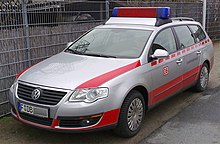
Only the following emergency vehicles may be equipped with blue all-round lights ( Section 52 StVZO):
(3) The following may be equipped with one or more beacons for blue flashing lights - all-round lights:
- Motor vehicles used for the enforcement service of the police , the military police , the federal police , the customs service , the Federal Office for Goods Transport or the Federal Office for Aircraft Accident Investigation , in particular command , patrol , crew transport , traffic accident , murder commission vehicles ,
- Emergency and command vehicles of the fire brigades and the other units and facilities of the disaster control and the rescue service ,
- Motor vehicles which, according to the vehicle registration document, are recognized as accident rescue vehicles for public transport companies with track-guided vehicles, including trolleybuses,
- Rescue service vehicles that are specially equipped for patient transport or emergency rescue and that are recognized as ambulances according to the vehicle registration certificate.
The simultaneous use of blue light and subsequent tone horn , the latter known colloquially especially in Germany as the Martinshorn (registered trademark of the inventor Max B. Martin), is commonly referred to as a special signal . However, electronically generated sound signals are increasingly being used instead of a trailing horn.
In addition, § 38 StVO:
(1) Blue flashing light together with the emergency horn may only be used when the greatest urgency is required in order to save human life or prevent serious damage to health, to avert a danger to public safety or order, to pursue fugitives or to preserve important property.
It orders:
"All other road users have to create a free path immediately".
(2) Blue flashing light alone may only be used by vehicles equipped with it and only to warn at accident or other deployment sites, when driving out or accompanying vehicles or by closed associations.
Only the simultaneous use of a blue flashing light and a tone horn makes it clear that emergency vehicles have priority in Germany, and the other road users must immediately clear them ( right of way ). In Austria, however, it is sufficient to use one of the two signals.
Regulation in Austria
In Austria, rotating beacons must comply with ECE regulation 65 in accordance with Section 15a (3) of the Motor Vehicle Act Implementation Ordinance 1967 .
The use of the yellow rotating beacon is regulated by Section 99 (6) KFG 1967 , whereby warning people emitting yellow-red light are referred to here.
When installing the blue rotating beacon, a distinction is made between vehicles that require a permit for the installation of blue lights and those that are allowed to mount it without a permit.
Vehicles that do not require a permit
According to § 20 para. 1 lit. d KFG 1967 may be fitted with blue lights on the following vehicles without a permit :
- Vehicles intended for use in the field of public security services
- Vehicles that are used in the field of military self-protection as well as the military patrol
- Vehicles that are intended for use by organs of the tax authorities in accordance with the provisions of the Tax Administration Organization Act - AVOG, Federal Law Gazette No. 18/1975
- Fire engines
- Ambulance vehicles owned by local authorities
- Vehicles in possession of the facilities named in Section 23 Paragraph 1 Z 1 to 5 of the Paramedic Act, Federal Law Gazette I No. 30/2002 (these are the Arbeiter-Samariter-Bund , Johanniter-Unfall-Hilfe in Austria , the Malteser Hospitaldienst Austria , the Austrian Red Cross and the Medical Service of the Federal Armed Forces ), which are used for urgent rescue operations, major incidents or disaster relief
- Vehicles that are used by road inspection bodies sworn in accordance with Section 97 (2) StVO to accompany special transports, provided that the use of blue lights in the notification pursuant to Section 39, Section 82 (5), Section 101 (5) or Section 104 (9) is a requirement was prescribed for transport security for the duration of this transport escort.
Vehicles that require a permit
According to Section 20 (5) KFG 1967 , blue lights may only be attached to the following vehicles with a permit if their use is in the public interest and, on the other hand, there are no concerns from the point of view of traffic and operational safety and are only intended for the following uses:
- Vehicles exclusively or mainly for fire brigades
- Vehicles for the public service
- Vehicles for the rescue service or the mountain rescue service
- Vehicles for the medical on-call service of local authorities, medical associations or social security agencies
- Vehicles for the performance of urgent medical help by doctors in areas with heavy traffic, in which there is no emergency medical service manned by a doctor and no medical on-call service according to lit. d are available; Before the decision on an application for the granting of a license, a statement from the Medical Association on the question of the necessity of granting this license must be obtained
- Vehicles for the performance of urgent emergency services in cooperation with fire brigades or public emergency services in traffic accidents in which vehicles for the transport of dangerous goods are involved
- Vehicles for the provision of urgent veterinary assistance by veterinarians in high traffic areas where no veterinary ambulance service is available; Before deciding on an application for the granting of a license, a statement from the Chamber of Veterinarians on the question of the necessity of granting this license must be obtained
- Vehicles for the performance of urgent medical assistance by specialists (in areas with heavy traffic), provided they are on call due to organizational regulations of the hospital
- Vehicles for freelance midwives who are authorized to deliver home births to help them reach the home birth place more quickly
- for urgent interference suppression of radio and communication systems as well as control centers of the BOS organizations ( authorities and organizations with security tasks ).
The above list is exhaustive. No blue light permit can be issued for other vehicles.
According to Section 20 (4) KFG 1967, the governor is responsible for issuing the permit . According to Section 20 (6) KFG 1967, this must also impose appropriate conditions or time, location or material restrictions on the validity.
Regulation in Switzerland
Each canton in Switzerland has its own, individual approval practice. For a long time, mirror optics were not permitted which were mounted under the same dome as the rotating mirror itself and which led to a running light effect. However, the canton of Geneva tolerated them. The same applies to multiple mirrors (double mirrors or lamps offset by 180 °).
In the case of particular danger, the blue lights may be used on stationary emergency vehicles to protect against accidents or danger spots, but only until other safety measures have been taken. In Switzerland, blue flashing lights and alternating sound horns may only be switched on on vehicles if the emergency vehicle actually claims and exercises its priority, i.e. during emergency trips. Out of consideration, missions are often carried out at night without alternating horns. If only blue flashing lights are used, there is no priority. As soon as emergency vehicles or rescue vehicles enter the autobahn, the following traffic is prohibited from overtaking, since every overtaking vehicle represents a potential future obstacle. In practice, this rule is usually enforced in such a way that the vehicles entering the motorway pull out and drive in a staggered manner across all lanes. This creates a locking bar that prevents the following traffic from overtaking.
Mainly on police vehicles, orange direction indicators are mounted on the warning bar or the vehicle roof so that yellow warnings can be given. However, the 21 watt incandescent lamps with Fresnel lenses used are much darker than the blue rotating beacon with H-1 55 watts (12 volts) or H-1 70 watts (24 volts) lamps.
Since the end of the 1990s , blue signal bars with integrated orange flashing lights have also been permitted in Switzerland. In addition to the blue flashing lights, the orange warning lights are not infrequently switched on during the emergency drive, which increases the visibility of the emergency vehicle, but is not in accordance with the law.
Regulation in Liechtenstein
Vehicles of the police and medical services (possibly also emergency doctors) as well as specially equipped vehicles of the fire brigade, mountain rescue and Samaritans, which announce themselves by flashing lights and changing horns, have the right of way in road traffic, also with traffic regulation by light signals (Art 18 VRV).
Blue light and alternating sound horn may only be used
- as long as the business trip is urgent and
- the traffic rules cannot be complied with (Art 18 Para. 3 VRV).
The business trip is urgent if compliance with the traffic rules would make it impossible to perform the tasks. Non-observance of the traffic rules, however, must neither endanger nor unreasonably hinder other road users (Art 94a VRV).
See also
- Subsequent tone horn
- Beacon
- All-round combination
- Position light (shipping)
- Sparkling light (shipping)
literature
- Josef Schütz: The Red books, Issue 8 - Fire trucks Part I . 11th edition. Kohlhammer, Stuttgart 1996, ISBN 978-3-17-013954-1 .
Individual evidence
- ^ Additional Protocol of June 8, 1977 to the Geneva Convention of August 12, 1949 on the Protection of Victims of International Armed Conflicts (Protocol I). (PDF; 315 kB).
- ↑ ASSEMBLY, No. 2998 STATE OF NEW JERSEY 211th LEGISLATURE. June 7, 2004, accessed June 21, 2018 .
- ↑ Federal Office of Justice: KVR Rule 23, letter b.
- ↑ ECE 65 ( Memento from May 15, 2012 in the Internet Archive ) (PDF; 779 kB)
- ↑ Legal sentence from the RIS to VwGH decision GZ 0638/74 of October 23, 1974
- ↑ Traffic Regulations of August 1, 1978, LGBl 19/1978.
